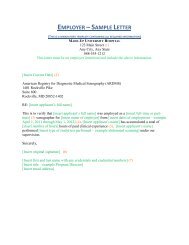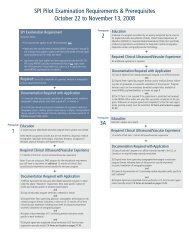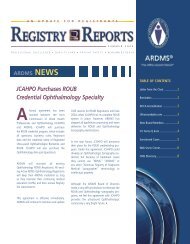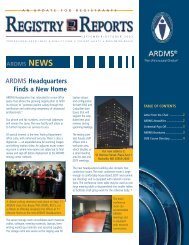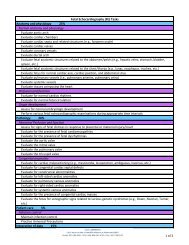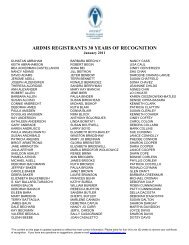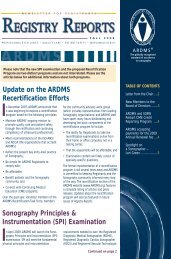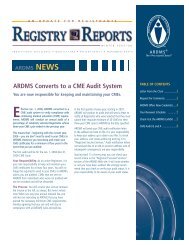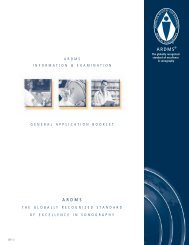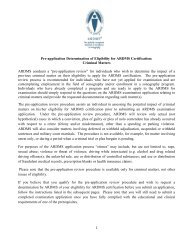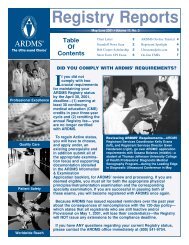Registry Reports - ARDMS
Registry Reports - ARDMS
Registry Reports - ARDMS
Create successful ePaper yourself
Turn your PDF publications into a flip-book with our unique Google optimized e-Paper software.
<strong>Registry</strong> <strong>Reports</strong><br />
Volume XVIII, Number 1<br />
Jan./Feb. 2001<br />
®<br />
®<br />
®<br />
Index<br />
CME Documentation 1<br />
Chair Letter 2<br />
New Breast Foundation 3<br />
On-line CMEs 3<br />
Registrant Spotlight 4<br />
New OSHA Rules 6<br />
Occupational Injury 7<br />
CME Calendar 8<br />
<strong>Registry</strong> <strong>Reports</strong><br />
Cathy A. Babiak,<br />
MRT(R), RDMS<br />
Chair, <strong>ARDMS</strong> Board of<br />
Directors<br />
Dale R. Cyr,<br />
MBA, RDMS, RDCS<br />
Executive Director<br />
Dana Murphy<br />
Director, Communications<br />
& Marketing<br />
Karla M. Smith<br />
Publications Coordinator<br />
<strong>Registry</strong> <strong>Reports</strong> welcomes<br />
submissions from the field.<br />
Send inquiries to: Karla<br />
Smith, Editor, <strong>Registry</strong><br />
<strong>Reports</strong>. Fax: (301) 517-8511<br />
E-mail: soundoff@ardms.org<br />
<strong>Registry</strong> <strong>Reports</strong> is a bimonthly<br />
publication of<br />
<strong>ARDMS</strong>.<br />
© 2001, Rockville, MD<br />
The ideas and opinions<br />
expressed herein do not<br />
necessarily reflect those<br />
of <strong>ARDMS</strong>.<br />
Professional Excellence Quality Care e Patient Safety Worldwide W<br />
Reach<br />
<strong>ARDMS</strong> CONTINUING MEDICAL EDUCATION:<br />
WE WANT YOUR CME DOCUMENTATION!<br />
CME EDUCATION SERIES, PART 1<br />
Thank you for your prompt response in remitting your<br />
CME documentation. The Registrant Services staff has<br />
been “snowed under” by the number of documents<br />
received in the last 60 days. Due to the recently<br />
adopted policies regarding the continuing competency<br />
requirement and the eventual loss of certification,<br />
should registrants fail to comply with the requirement<br />
of earning 30 continuing medical education credits in a<br />
three-year tracking period, we recommend that you send<br />
in your CME documentation throughout the year. In doing<br />
so, please note that all continuing education course credits must<br />
be validated by a certificate or letter of attendance from an approved<br />
provider, and must include the following information:<br />
1) Complete Name of Registrant<br />
2) <strong>ARDMS</strong> <strong>Registry</strong> Number<br />
3) Date of Course or Activity<br />
4) Title of Course or Activity<br />
5) Approved Sponsor (see list, below)<br />
6) Total Number of Credits Awarded<br />
THE ROLLING CONCEPT<br />
THE ROLLING CONCEPT<br />
If you are a Registrant with a tracking period of 1/1/1999<br />
through 12/31/2001, to retain your Active CME status you must<br />
have, by the last day of this period, a total of 30 CME credits.<br />
After it has been determined that you have met the requirement,<br />
based on the “rolling” concept, the number of CME credits you<br />
earned in 1999 will “roll off” (be deleted from your <strong>ARDMS</strong><br />
transcript), and you will have in reserve (for use for the next<br />
period) the number of credits you earned in 2000 and in 2001.<br />
Tracking Period: 1/1/1999 – 12/31/2001<br />
For example:<br />
Year<br />
Number of CME credits<br />
1999 10<br />
2000 11<br />
2001 12<br />
Total<br />
33 credits<br />
Tracking Period: 1/1/2000 – 12/31/2002<br />
The 10 credits earned in 1999 have “rolled off”<br />
Year<br />
Number of CME credits<br />
1999 10 (previous year)<br />
2000 11<br />
2001 12<br />
2002 7 (earn # of credits equal to 30)<br />
Total<br />
30 credits
LETTER FROM THE CHAIR<br />
Cathy A. Babiak, MRT(R), RDMS<br />
New Rule about Possible Loss of<br />
<strong>Registry</strong> Status: What It Means to You<br />
The new <strong>ARDMS</strong> policy about what<br />
registrants must do to maintain their<br />
status as an Active registrant has quite<br />
understandably, led to some turmoil and confusion for some<br />
of our registrants.<br />
First—in case you have somehow missed all of the<br />
multiple mailings on this policy—here is the text of the new<br />
rule, as adopted by the <strong>ARDMS</strong> Board of Directors:<br />
“Effective December 31, 2000, all registrants who have not<br />
met CME requirements by accumulating 30 continuing<br />
medical education credits in a 3-year cycle and have not<br />
paid outstanding <strong>Registry</strong> fees will have 120 days (until<br />
April 30, 2001) to document compliance with these<br />
requirements. If after this time a registrant has failed to meet<br />
these requirements, he/she will no longer be considered a<br />
registrant.”<br />
The price for loss of registrant status is, intentionally, fairly<br />
steep: If you lose your <strong>Registry</strong> status on April 30 2001, you<br />
will be required to retake the exams you needed for your<br />
credential(s) in the first place and, once again, earn a passing<br />
grade on each.<br />
We realize that coming into compliance under this new<br />
policy has meant, for some registrants, the arduous task of<br />
compiling and faxing to <strong>ARDMS</strong> large stacks of CME<br />
documents, and in other cases, scrambling to take enough<br />
new CMEs to meet the established deadlines for submission<br />
of these credits.<br />
At the same time, many of you have had questions for<br />
<strong>ARDMS</strong> about the new requirements for Active status and,<br />
in particular, about your own personal <strong>Registry</strong> record and<br />
the possible implications of its current contents.<br />
Know that everyone on the <strong>ARDMS</strong> staff has bent over<br />
backwards to try and answer every one of your phone calls,<br />
promptly and helpfully. But with thousands of phone calls<br />
coming in every day, the staff would like to extend an<br />
apology if you were, on some occasion, unable to have your<br />
call taken promptly by an <strong>ARDMS</strong> staff member.<br />
If this transition to a new policy on Active <strong>ARDMS</strong><br />
<strong>Registry</strong> status has been rough for you, please try to<br />
concentrate on the underlying intent of the policy: to bolster<br />
the value and prestige of all your <strong>ARDMS</strong> credentials. We<br />
hope you agree that this is an objective that is well worth<br />
striving for.<br />
E-mail: cbabiak@ardms.org<br />
A LETTER FROM AN<br />
INTERNATIONAL TIONAL REGISTRANT<br />
The Role of Ultrasound in Private General Practice<br />
I have been in general-practice medicine for 25 years. In<br />
my country (Pakistan), the health-systems structure is not<br />
developed properly, due to the poor economy and lack of<br />
advanced facilities. The general practitioner is often the<br />
first to come in contact with the patient.<br />
In our practice, we deal with surgical emergencies, general<br />
medicine, and OB/GYN, including many other kinds of<br />
cases as well. Because a full clinical investigation is frequently<br />
unaffordable for many patients, I think that ultrasound<br />
specialists, with proper qualifications and training,<br />
can play an important role in diagnosis and referral, in<br />
addition to reducing the cost of treatment.<br />
I have performed ultrasound examinations since 1991.<br />
When I heard about a <strong>Registry</strong> examination in ultrasonography,<br />
I did not waste much time. I went to the U.S.<br />
and qualified as a Registered Diagnostic Medical<br />
Sonographer (RDMS), with a specialty in OB/GYN. My<br />
special thanks to <strong>ARDMS</strong> Testing Director Tim Sares and<br />
Registrant Services Director Gwen Henderson for helping<br />
me during that period. Since then, I have returned to my<br />
country, and now have more confidence about my skills,<br />
and greater insight into the field of ultrasonography. My<br />
small ultrasound machine (though not very expensive) is a<br />
great help to me in diagnosing cases. During the last year, I<br />
was able to diagnose hepatitis, cholelithiasis, kidney stones,<br />
glomerulonephritis, malignancy, pyelonephritis, and so on.<br />
My main interest is in acute abdomen. I diagnosed 10<br />
cases of appendicitis (with only two negative results). In<br />
eight cases, surgery was performed within hours of my<br />
diagnosis, which saved several patients’ lives...without high<br />
cost or wasted time. Few cases had positive ultrasound<br />
findings before the patients' pain shifted to the right iliac<br />
fossa. Some patients whose conditions were diagnosed,<br />
using ultrasound, as acute hepatitis and who had correlating<br />
positive blood tests were treated as outpatients. Also, two<br />
patients who had tubal pregnancies were able to reach the<br />
hospital in time.<br />
I believe proper ultrasound training and skill testing should<br />
be introduced into Third World countries. There should also<br />
be awareness among professionals about proper training in<br />
ultrasound, so patients who are poor can avail themselves of<br />
inexpensive diagnostic ultrasound facilities. These measures<br />
would go a long way toward advancing the cause of public<br />
health in my country and in other Third World countries.<br />
Dr. Firoza Zahir, RDMS<br />
2 January/February 2001 • <strong>Registry</strong> <strong>Reports</strong>
Announcement! The Breast Cancer and<br />
Women’s Health Ultrasound Foundation<br />
The <strong>ARDMS</strong> is pleased and proud to announce the launch of its new foundation:<br />
The Breast Cancer and Women’s Ultrasound Foundation. The Foundation<br />
has assembled, and convened in person for the first time on January 7, 2001, to<br />
an impressive and diverse Board of Directors made up of sonographers, physicians,<br />
and representatives of the general public, including a breast cancer survivor.<br />
Many women do not know about the diverse applications of ultrasound that have become available in recent years.<br />
Prominent among these has been the emerging use of ultrasound as an important adjunct to mammography in the<br />
diagnosis of breast disease. Women need to know that an ultrasound exam can, in many cases, provide critical<br />
information for diagnosing cancers, as well as several other common conditions, in the breast.<br />
In order to fill this critical knowledge gap, <strong>ARDMS</strong> has established the Foundation—a unique organization that will<br />
have the key resources needed to fill the critical need for widespread, effective dissemination of the public-health message<br />
about ultrasound. To get the word out to as many women as possible, the Foundation will develop strategically<br />
integrated use of every suitable medium—the Web, lay and professional print publications, television and radio, and<br />
videotape—to reach a “critical mass” of information about the benefits of ultrasound procedures. When that critical<br />
mass has been attained, women themselves will be empowered to ask important questions about ultrasound procedures.<br />
While other organizations focus on basic research, this Foundation will concentrate its efforts—by promoting<br />
awareness about ultrasound as a procedure that can help improve diagnosis in women. To guide its important work, the<br />
Foundation’s Board of Directors comprises some of the most eminent names in the field of cancer, and breast cancer<br />
in particular.<br />
Clearly, the other goals of the Foundation—to build awareness about the benefits of ultrasound tests, and to expand<br />
women’s utilization of them—will not be attainable unless there are sufficient numbers of sonography professionals<br />
armed with the expertise needed to do breast ultrasound tests thoroughly and accurately.❖<br />
Increase the Pool of <strong>ARDMS</strong>-certified Breast Ultrasound Sonographers: For more information<br />
about the new Breast specialty exam, visit the <strong>ARDMS</strong> Website (www.ardms.org). The Breast<br />
Content outline is now available on the <strong>ARDMS</strong> site, in addition to other content outlines.<br />
FOR FREE<br />
FOR A SMALL FEE<br />
ON-LINE<br />
CMES<br />
ATL Ultrasound:<br />
www.atl.com/pro_ed/E2102_Casestudy<br />
Acuson:<br />
www.acuson.com<br />
Biosound:<br />
www.biosound.com/cme.html<br />
GE:<br />
www.ge.com/medical/ultrasound/msucme.html<br />
Jackson:<br />
www.jackson.cc.mi.us/CME<br />
AIUM:<br />
www.aium.org/cme/cmes_offered.<br />
html<br />
MedEd Interactive:<br />
www.mededinteractive.com<br />
HP:<br />
www.hp.com/go/soundings<br />
Institute for Advanced Medical Education:<br />
www.iame.com/learning/online.html<br />
<strong>Registry</strong> <strong>Reports</strong> • January/February 2001 3
REGISTRANT SPOTLIGHT<br />
Phillip G. Ladisa, RT, R , RDMS, and<br />
Julie Ladisa, RDMS<br />
In this issue of <strong>Registry</strong><br />
<strong>Reports</strong>, we interviewed<br />
father and daughter sonographers,<br />
Phillip G. Ladisa, RT,<br />
RDMS, and Julie Ladisa,<br />
RDMS. For 15 years, Phillip<br />
has been a staff sonographer at<br />
West Suburban Hospital in<br />
Oak Park, Illinois. Julie has<br />
worked as a staff sonographer at Resurrection Medical<br />
Center in Chicago for the last three years.<br />
What inspired you to get involved with sonography?<br />
PHILLIP: “My parents have always played an influential<br />
role in my life. However, it was the advice of my father,<br />
Alex, and my grandmother Angeline (who was an X-ray<br />
technologist) that perpetuated my interest in radiology and<br />
growing further in diagnostic ultrasound.”<br />
JULIE: “My father inspired me to become a sonographer.<br />
I also had a strong career desire to help other people. At age<br />
17, I had a sudden onset of severe abdominal pain. My doctor<br />
ordered an ultrasound for me. My father performed the<br />
exam. The results showed a ruptured ovarian cyst. During<br />
the exam, my father turned the machine around so I could<br />
view it, and explained everything he was looking at. I was<br />
able to see what the inside of my body looked like. I was so<br />
intrigued by his profession and I became so fascinated by his<br />
work that I shadowed my father while he worked. He<br />
patiently taught me, and I eagerly learned. I graduated from<br />
an accredited program at Triton College. He has been my<br />
mentor ever since.”<br />
What are your specialties?<br />
PHILLIP: “Although my RDMS is in abdominal, my<br />
technical experience also includes OB-GYN, adult echocardiography,<br />
vascular technology, and small parts procedures.”<br />
JULIE: “My specialty is abdominal sonography. However,<br />
I am proficient in OB-GYN, vascular, small parts, neonatal<br />
heads, and abdominal Doppler, as well as assisting<br />
physicians in biopsies and amniocentesis.”<br />
How does your work affect your patients?<br />
PHILLIP: “I would like to think that it affects them in a<br />
positive sense. After all, humor is often said to be the best<br />
medicine. However, a respectful and tactful attitude is still a<br />
must.”<br />
JULIE: “My work affects the lives of my patients by the<br />
quality of the care I provide. I am a true believer in being<br />
respectful and professional at all times. I want all of my<br />
patients to be comfortable and have the utmost trust in me.”<br />
Describe a typical workday.<br />
PHILLIP: “Because of family health reasons, I have<br />
requested that my shift be in the evenings. Most scheduled<br />
studies are done during this time, which limits emergency<br />
studies ordered by ER, LD, and ICU.”<br />
JULIE: “A typical workday at Resurrection Medical<br />
Center is very busy. I work under the direction of Dr. Moss<br />
in a dynamic ultrasound department. I perform a variety of<br />
exams throughout the day. I try to make reference to<br />
literature, when possible abnormalities are found. It is<br />
important for me to enhance my learning process as much<br />
as possible. I interact with patients, physicians, and other<br />
health professionals to ensure proper care is given. In<br />
addition, the institution where I am employed is a teaching<br />
hospital. Therefore, this gives me the opportunity to work<br />
with students and my peers. It is an honor for me to<br />
clinically instruct students properly for clarity of thought<br />
and ease of understanding. Working with others is important<br />
to me. It keeps me on my toes and abreast of the field of<br />
ultrasonography.”<br />
What is the most interesting case you worked on, and<br />
what was the result?<br />
PHILLIP: “One of the most interesting cases I have ever<br />
seen was detecting a left atrial myxoma in a 59-year-old<br />
male outpatient whose only complaint was occasional chest<br />
pain. Surgery was successfully performed by Dr. John<br />
Natale, at Northwest Community Hospital in Arlington<br />
Heights, Illinois.”<br />
JULIE: “The most interesting case I worked on was an<br />
emergency call case. A 65-year-old female came into the ER<br />
because she had fallen down the stairs at home. She came in<br />
walking and talking. As she was being evaluated her<br />
conditioned worsened. The woman coded after the CT scan<br />
of her head was completed. The doctors could not evaluate<br />
the abdominal region because her life was in danger. After<br />
rushing her back to the emergency room, the doctors called<br />
me in to do a portable exam. Her hemoglobin was dropping<br />
fast. They were concerned that she had possible internal<br />
bleeding. She was now on a balloon pump and vent. As I<br />
scanned the quadrants, I found minimal fluid. There were<br />
about 10 people in a tiny room trying to save her life. At<br />
least six doctors of various specialties were surrounding me.<br />
I then surveyed the abdomen and found a ruptured<br />
aneurysm. There was not a significant amount of fluid.<br />
Concentrating on the aorta, I found a dissection at the<br />
proximal region. As soon as my radiologist confirmed the<br />
finding, the woman coded again and died. I found out what<br />
was wrong and it was still too late. It is difficult to assess the<br />
aorta for a dissection, as most sonographers know. However,<br />
this was a textbook case of an aortic dissection and rupture.<br />
This was also confirmed on an autopsy later that month.”<br />
See Ladisa, continued on next page<br />
4 January/February 2001 • <strong>Registry</strong> <strong>Reports</strong>
Ladisa, Continued from Page 4<br />
“Understanding anatomy, the disease process,<br />
and physics is imperative. Applying these skills<br />
makes my scanning more proficient and me a<br />
better sonographer.” ––Julie Ladisa, RDMS<br />
How do you use your skills in your work?<br />
PHILLIP: “I feel it is a combination of not only skills I<br />
was taught in school, but also experience that is applied to<br />
everyday study.”<br />
JULIE: “In my work, I use my skills by applying different<br />
strategies and techniques to get the image with the most<br />
information. I also utilize the machine’s proper instrumentation.<br />
I always try different things to optimize the image.<br />
My excellence in technique stems from my knowledge.<br />
Understanding anatomy, the disease process, and physics is<br />
imperative. Applying these skills makes my scanning more<br />
proficient and me a better sonographer.”<br />
What do you find most challenging?<br />
PHILLIP: “Every ultrasound procedure is challenging<br />
because you cannot predict the results prior to performing<br />
the study.”<br />
JULIE: “The most challenging area of ultrasound is trying<br />
to shut off my emotions. There are many times I become<br />
upset because of hopeless situations. It is a mental challenge<br />
to let go of pain and sadness.”<br />
PHILLIP: “It is very difficult to act as though everything<br />
is ‘normal’ especially when you are performing an OB study,<br />
and the fetus turns out to be encephalic. Parents are excited<br />
about being pregnant, so being tactful in the way you<br />
present yourself is very important, no matter how<br />
devastating the results are.<br />
“Some time ago, I performed an echocardiogram on a<br />
middle-aged female (who was a dialysis patient). Shortly<br />
before starting the procedure, I saw the ordering cardiologist<br />
before he left the hospital. After a very short time into the<br />
exam, I had detected a large pericardial effusion<br />
(Tamponade). I remember calling another technologist to<br />
stay with my patient and excusing myself, while I ran to the<br />
parking lot, hoping to be able to catch her doctor and advise<br />
him of the finding. To my surprise, I was able to, and he<br />
instructed me to send her to the emergency room<br />
immediately where he met and treated her.”<br />
What do you find most rewarding?<br />
PHILLIP: “It is very rewarding to able to determine what<br />
and where an abnormality is. However, it is even more<br />
rewarding to see my patients for their routine follow-up<br />
studies in their fully recovered states.”<br />
JULIE: “The most rewarding part of my job is my<br />
personal happiness. I am proud to say I have a passion for<br />
my work. Helping others and making a difference in their<br />
lives will forever enrich mine.”❖<br />
REGISTRANT SERVICES IS<br />
WORKING HARD FOR YOU!<br />
On behalf of all of us at <strong>ARDMS</strong>,<br />
and especially the staff in<br />
Registrant Services, please accept<br />
our sincere apologies if your<br />
phone call was, at times, unable to<br />
get through to a Registrant<br />
Services staff member. Please<br />
know that we are all doing our<br />
utmost to serve your needs, at all<br />
times, with a highly dedicated,<br />
staff. And please bear in mind that<br />
we have been undergoing some<br />
major changes here at <strong>ARDMS</strong>,<br />
including a switch to a new and<br />
more powerful database, which<br />
will very soon allow you to serve<br />
your own needs as a registrant,<br />
quickly and accurately. Also, we<br />
have been very much occupied in<br />
mailing out documents, on time, to<br />
11,000 registrants. In a few weeks,<br />
we hope, the volume of work here<br />
at <strong>ARDMS</strong> will return to its usual<br />
level–always high, but not quite<br />
the avalanche we've seen in recent<br />
weeks. Then, we will be better able<br />
to respond to your calls more<br />
promptly.❖<br />
The new vascular technology content<br />
outline is now available on our<br />
Website (www.ardms.org). The<br />
vascular technology examinations<br />
reflect these content outline changes.<br />
<strong>Registry</strong> <strong>Reports</strong> • January/February 2001 5
OSHA Issues New Rules on<br />
Ergonomic Standards<br />
In a new regulation that will go into effect on January 15,<br />
2001, the U.S. Occupational Safety and Health<br />
Administration (OSHA) has spelled out what it terms a<br />
“musculoskeletal incident,” and has provided detailed<br />
guidance indicating what employers must do to correct these<br />
incidents. Knowing the specifics of what is contained in this<br />
rule will help sonographers make certain that they get the<br />
remedies due them under law from what has<br />
been called<br />
“scanning in pain.”<br />
The regs were<br />
developed to reduce<br />
the number and<br />
severity of musculoskeletal<br />
disorders<br />
(MSDs) caused by<br />
(among other risk factors)<br />
repetitive motions<br />
and awkward postures.<br />
The assumption underlying<br />
the new rules is<br />
that these problems can<br />
be eliminated, or<br />
greatly reduced, “by fitting<br />
the job to the worker<br />
through adjusting a workstation,<br />
rotating between<br />
jobs, or using mechanical<br />
assists.” (OSHA Standard<br />
1910.900)<br />
Under the rule, employers<br />
have an obligation to educate their employees about MSDs.<br />
Specifically, they must inform their workers about potential<br />
MSDs and their signs and symptoms, as well as the importance<br />
of reporting MSDs, how to file reports, the particular<br />
jobs and risk factors most likely to cause MSDs, and a short<br />
description of what is required under OSHA’s ergonomic<br />
standards.<br />
How must employers deal with MSDs, according to<br />
OSHA’s standards? OSHA has specified several sets of<br />
criteria that must be met, each of which prompts a<br />
particular action.<br />
1. If an employee reports an MSD, the employer must<br />
(after consultation of a healthcare provider) determine if the<br />
problem constitutes a “musculoskeletal incident,” as defined<br />
according to OSHA’s criteria:<br />
“(i) The MSD is work-related and requires days away from<br />
work, restricted work, or medical treatment beyond first aid;<br />
or (ii) The MSD signs or symptoms are work-related and last<br />
for 7 consecutive days after the employee reports them [to<br />
the employer].” (OSHA Standard 1910.900)<br />
6 January/February 2001 • <strong>Registry</strong> <strong>Reports</strong><br />
2. Next, the employer must determine if the MSD meets<br />
the criteria for what OSHA terms an “action trigger.” A job<br />
meets the action trigger if (1) the MSD incident occurred on<br />
the job, and the job involves routine—on more or more days<br />
each week—one of the risk factors listed by OSHA.<br />
3. If a job meets the criteria for the action trigger, employers<br />
can either implement what OSHA calls “the Quick Fix<br />
option” (basically, re-engineer the job within 90 days so that<br />
the MSD is eliminated), or set up a full-fledged ergonomics<br />
program. This program must<br />
include management<br />
leadership and employee<br />
participation, job-hazard<br />
analysis, hazard-reduction<br />
and control measures<br />
(with ongoing evaluation<br />
of their effectiveness),<br />
and employee training in<br />
the MSD-remediation<br />
measures adopted by<br />
the employer.<br />
Any employer<br />
with more than 11<br />
employees will have to<br />
keep detailed records<br />
on all of this, including<br />
employee reports<br />
of MSDs and MSD<br />
hazards, the<br />
employer’s response<br />
to these reports, the<br />
job-hazard analysis,<br />
and the hazard-control measures put<br />
in place to remedy the reported MSDs.<br />
But will this regulation have any real impact, in terms of<br />
potential penalties to employers? An OSHA spokesman to<br />
<strong>Registry</strong> <strong>Reports</strong> seemed a bit guarded about this, noting,<br />
“The standard isn’t final until January 1, 2001, and the first<br />
elements in terms of compliance with it won’t go into effect<br />
until October 15. Until that time, we’re just looking to<br />
educate employers about what’s contained in the<br />
regulations.”<br />
He also pointed out that this standard represents new<br />
territory for OSHA. But when pressed, he did note that the<br />
penalties for non-compliance would probably resemble those<br />
used in enforcing OSHA’s standards on airborne pathogens.<br />
If OHSA hears that an employer is violating these standards,<br />
an OSHA inspector visits the site. If the complaint is<br />
verified, OSHA and the employer jointly develop an<br />
abatement schedule for the violation. If the employer fails to<br />
make sufficient progress in abatement, then OHSA penalties<br />
kick in. They may be as low as $7,000, the OHSA<br />
spokesman noted, but can be as high as $1 million, “if a<br />
company repeatedly and knowing commits a violation. ❖
Industry Experts Form Innovative Company to<br />
Address Occupational Injury Among Sonographers<br />
Surveys over the past five years have unequivocally<br />
demonstrated that work-related injury among<br />
sonographers is a serious problem. Sound Ergonomics,<br />
L.L.C., a Washington-based consultant group, brings<br />
together three leading experts to address the issues related<br />
to the ergonomics of ultrasound practice.<br />
The company consists of Joan Baker, first chair of <strong>ARDMS</strong><br />
and former president of the SDMS; Carolyn Coffin,<br />
program director of the University of Colorado Ultrasound<br />
program in Denver; and Susan Murphey, faculty member<br />
in Ultrasound at Bellevue Community College in Bellevue,<br />
WA; and injury-prevention specialist.<br />
In accordance with the recent regulations on ergonomics<br />
from OSHA, Sound Ergonomics, L.L.C., provides clinicalsite<br />
evaluations and in-service education, to prevent<br />
ergonomic-related injuries among sonographers, vascular<br />
technologists, and cardiac sonographers.<br />
In addition, Sound Ergonomics, L.L.C., consultants focus<br />
on the complexity of risk-related factors by providing local<br />
educational seminars and equipment-design consulting.<br />
Visit the company’s Website, at www.soundergonomics.com,<br />
or contact Sound Ergonomics directly at (206) 417-8151.❖<br />
<strong>Registry</strong> <strong>Reports</strong> • January/February 2001 7
®<br />
®<br />
600 Jefferson Plaza • Suite 360 • Rockville, Maryland • 20852-1150<br />
PRESORTED STD<br />
U.S. POSTAGE<br />
PAID<br />
Dulles, VA<br />
Permit No. 056<br />
www.ardms.org<br />
CME CALENDAR<br />
This calendar of ultrasound meetings and review courses may help you find places<br />
to earn CME credits. <strong>ARDMS</strong> publishes meeting notices as an information source<br />
only. Registrants seeking CME credits should ensure in advance that <strong>ARDMS</strong><br />
accepts the sponsor of a particular activity. Meetings are listed based on space<br />
availability. If you wish to have your meeting or school listed, please fax your<br />
information to the editor of <strong>Registry</strong> <strong>Reports</strong> at (301) 517-8511, or send your<br />
CME schedule via e-mail to soundoff@ardms.org.<br />
April 2001<br />
20-22 Current Practice of Vascular Ultrasound, Carotid and Transcranial Doppler,<br />
—Institute for Advanced Medical Education (IAME), Chicago, IL.<br />
Call (914) 921-5700, or e-mail info@iame.com.<br />
MAY 2001<br />
1 First Trimester Ultrasound: What’s New and Important?––Cedars-Sinai<br />
Medical Center, Los Angeles, CA . Call (310) 423-3361 or e-mail<br />
james.jenkins@cshs.org.<br />
2-5 The 22 nd Annual Scientific Sessions, North American Society of Pacing<br />
and Electrophysiology, Boston, MA. Call (508) 647-0100.`<br />
2-6 Clinical Essentials of CT & MRI—IAME), Las Vegas, NV.<br />
Call (914) 921-5700, or e-mail info@iame.com.<br />
27-31 The 3 rd World Congress of Pediatric Cardiology and Cardiac Surgery,<br />
Toronto, Canada. Call (416) 504-4500.<br />
June 2001<br />
1 Current Practice of Vascular Ultrasound—IAME, San Francisco, CA .<br />
Call (914) 921-5700, or e-mail info@iame.com.<br />
July 2001<br />
16 First Trimester Ultrasound:What’s New and Important?—Cedars-Sinai<br />
Medical Center, Los Angeles, CA. Call (310) 423-3361.<br />
The following organizations and<br />
companies offer CME opportunities<br />
too numerous to list here. Please<br />
contact them for further information.<br />
• Burwin Institute, U.S. and Canada<br />
(800) 322-0737<br />
www.burwin.com<br />
• Gulfcoast Ultrasound Institute,<br />
Inc., St. Pete Beach, FL<br />
(800) 619-1900 or (727) 363-4500<br />
www.gcus.com<br />
• ESP Ultrasound,<br />
Sidney K. Edelman, Ph.D.<br />
(281) 292-9400<br />
www.esp-inc.com<br />
• MedEd Interactive, nationwide<br />
(888) 639-0817<br />
www.mededinteractive.com<br />
• Jefferson Ultrasound Institute,<br />
Philadelphia, PA<br />
(888) 390-5051 or (215) 955-8533<br />
http://jeffline.tju.edu/ultrasound






